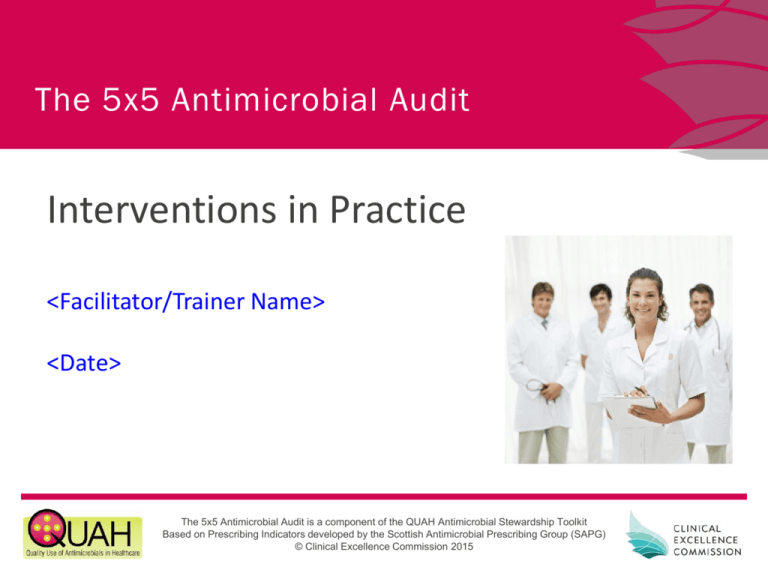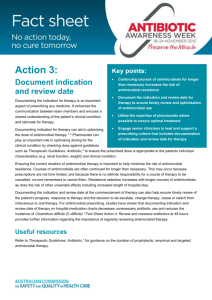MS Word ~1.4Mb
advertisement

The 5x5 Antimicrobial Audit Interventions in Practice <Facilitator/Trainer Name> <Date> The 5x5 Antimicrobial Audit is a component of the QUAH Antimicrobial Stewardship Toolkit Based on Prescribing Indicators developed by the Scottish Antimicrobial Prescribing Group (SAPG) © Clinical Excellence Commission 2015 Disclaimer • The information on the following slides are designed to allow healthcare professionals to practice interventions for the 5x5 Antimicrobial Audit • All patient cases are fictitious, and not intended to guide prescribing in the conditions described • Please refer to antimicrobial prescribing guidelines endorsed in your facilities if you require guidance for antimicrobial prescribing Learning outcomes • By the end of this session, participants will: – Describe how to effectively communicate with prescribers when making interventions – Identify enablers and barriers to optimal communication – Apply communication techniques to case scenarios 3 When an intervention is needed • When there is no clear indication for antimicrobial therapy documented in the patient’s notes, chart or electronic file • When the choice of antimicrobial therapy does not match guidelines for the stated indication AND The prescriber has not given a reason for divergence from guidelines 4 Barriers to making interventions • In your experience, have there been times when you’ve been reluctant to discuss issues to do with documentation or medication with prescribers? – Why were you reluctant? – What did you do? • What might be the outcomes of not making an intervention in the 5x5 Antimicrobial Audit? 5 Enablers to making interventions • In your experience, have you made a recommendation to a prescriber that was well-received? – What did you do? – Why do you think it was well-received? • What might be the outcomes of making an intervention in the 5x5 Antimicrobial Audit? – Think in both the short and longer term 6 Practice scenarios • Everyone will have a chance to practice their interventions today • Need some volunteers for group discussion • Pretend you are on the ward doing your usual work as a nurse, pharmacist, doctor or other healthcare professional • Role plays should be conducted in pairs, followed by debrief/discussion once out of role play 7 Case 1 • Mrs Beryl White was admitted to hospital yesterday. She is on empiric antibiotics and is eligible for the 5x5 Antimicrobial Audit. • She is on piperacillin-tazobactam 4.5g IV q8h and gentamicin 180mg IV daily. • The indication box on her medication chart is blank. You refer to her notes and see she came in with fevers and rigor. She has been feeling unwell for the last 5 days, and her medical history has been documented, along with her obs. She has multiple co-morbidities including diabetes and COPD. • The impression on admission was that she has: “?Sepsis ?UTI ?Chest infection” • The plan was “Start IV ABs, fluids” plus investigations 8 Case 1 – Mrs White • You decide that the indication is not clear enough to determine concordance with guidelines which contain: – Severe sepsis: empirical therapy (no obvious source of infection) – Severe sepsis, urinary tract source – Severe community acquired pneumonia – Severe sepsis, febrile neutropenic patients • The doctor looking after Mrs White today has just stepped on to the ward 9 Perform role play for case 1 Case 2 • Mr Jim Lee is a 75yo male admitted by ambulance following a fall. He was diagnosed with a fractured neck of femur, and went to operating theatre for surgery to repair his hip. • It is now 3 days after his surgery and you cannot see any evidence of microbiology specimens or results available. As he is on cephazolin 1g IV q6h you deem he is eligible for the 5x5 Antimicrobial Audit. • The indication box on his medication chart for cephazolin is blank. 11 Case 2 – Mr Lee • The progress notes mention his fall and “#(L) NOF” but there is no mention of his antibiotics. • You decide there is no indication documented for cephazolin, even though you suspect this was started as antibiotic prophylaxis just prior to his surgery. • You decide to call the orthopaedic surgery RMO. 12 Perform role play for case 2 Case 3 • Mrs Anna Garibaldi is a 68yo female admitted to MAU for pneumonia, by referral from her GP. • The admission notes indicate Mrs Garibaldi has: – Fever 38°C, sputum production and cough – Obs (ED): RR 22, HR 85, BP 110/70, O2 sats 92% on room air – CXR: Left lower lobe (LLL) consolidation – Imp: CAP – Plan: IV ceftriaxone and azithromycin • There are no microbiology results available, and you determine she is eligible for the 5x5 Antimicrobial Audit 14 Case 3 – Mrs Garibaldi • Mrs Garibaldi is on ceftriaxone 1g IV daily and azithromycin 500mg IV daily. • You decide that the indication is clear enough to answer “yes” to Q1. • You refer to your hospital guideline for CAP, which recommends: – Use of the SMART-COP or CORB score to determine severity – Use of IV benzylpenicillin and oral doxycycline for nonsevere CAP for hospital inpatients initially – Use of IV ceftriaxone and azithromycin for severe CAP initially 15 Case 3 • Mrs Garibaldi does not have ‘severe’ CAP using the SMART-COP or CORB criteria. She also does not have any known drug allergies. • The prescriber has not stated any reason for selecting IV ceftriaxone and azithromycin instead of the recommended IV benzylpenicillin and po doxycycline. • You decide to contact the doctor to recommend guideline-concordant therapy. 16 Perform role play for case 3 Case 4 • Mr Alexander Schneider is a 92yo male on the aged care ward admitted for “acopia” about 10 days ago. He was started on Augmentin Duo (amoxycillin + clavulanate 500+125mg) i po bd and Flagyl (metronidazole) 400mg po tds last night. • There are no microbiology results available, and he wasn’t on previous antibiotic therapy, so you determine he is eligible for the 5x5 Antimicrobial Audit. • You look at yesterday’s progress notes and notice that Mr Schneider deteriorated a little yesterday, became a little more drowsy than usual, spiked a fever (38°C) and began coughing up sputum. 18 Case 4 - Mr Schneider • The notes stated that the evening doctor that reviewed him diagnosed “likely mild hospital-acquired pneumonia”, ordered extra bloods and a chest x-ray, and commenced antibiotics. • You look up the guidelines for hospital acquired pneumonia and deem Mr Schneider to be at low risk of multi-resistant organisms. Recommended antibiotic therapy is: amoxycillin + clavulanate (875+125 mg) one tablet orally twice a day (12-hourly) for 5 to 7 days. • There is no documented reason for metronidazole, so you decide to contact the team looking after him today. 19 Perform role play for case 4 Case 5 • Mr Andrew Crispin is an 88yo frail elderly man admitted with RUQ pain, anorexia, nausea and vomiting, fever and jaundice. • You are in ED and note that he has been commenced on ampicillin 1g IV q6h and metronidazole 500mg IV bd. • Blood tests, an ultrasound have been order but no microbiology results are available. You determine he is eligible for the 5x5 Antimicrobial Audit. 21 Case 5 – Mr Crispin • You find a working diagnosis of “acute cholecystitis ?biliary obstruction” in the patient’s ED electronic medical record, along with his medical history and medication list. • You look up your hospital’s antimicrobial prescribing guidelines and the following antibiotics are recommended: amoxy/ampicillin 2g IV q6h PLUS gentamicin 4-5mg/kg IV stat, then review according to renal function PLUS metronidazole 500mg IV bd (or 400mg po bd) • You cannot find a reason documented in the notes for the omission of gentamicin, so you contact the doctor 22 Perform role play for case 5 Case 6 • Mrs Kim Tran is a 73yo female admitted with signs and symptoms of sepsis. She is febrile, hypotensive and tachycardic. • You note that she was commenced on IV antibiotics earlier this morning, and deem her eligible for the 5x5 Antimicrobial Audit. • Mrs Tram is on the following antibiotics: – flucloxacillin 2g IV 6-hourly – gentamicin 360mg IV stat – vancomycin 1g IV 12-hourly 24 Case 6 – Mrs Tram • You look through the notes for more information on the indication, but it just states “probable sepsis - ?origin”. • There are no microbiology results available yet today to guide her therapy, and she does not appear to have any drug allergies. • Flucloxacillin and gentamicin are recommended in your hospital for severe sepsis with an unknown source (CEC Sepsis Kills ED protocol). • You decide to talk to the doctor about the addition of vancomycin to Mrs Tram. 25 Perform role play for case 6 Revision of learning outcomes • By the end of this session, participants will: – Describe how to effectively communicate with prescribers when making interventions – Identify enablers and barriers to optimal communication – Apply communication techniques to case scenarios. 27 Thank you Questions? For further information, please contact: <name and contact details> 28






